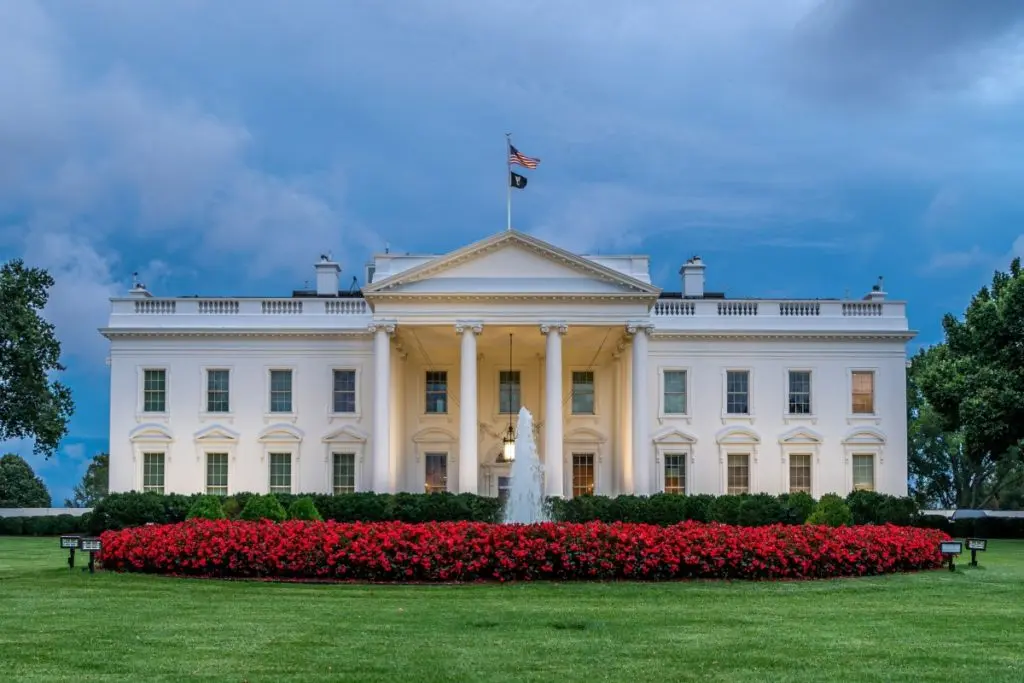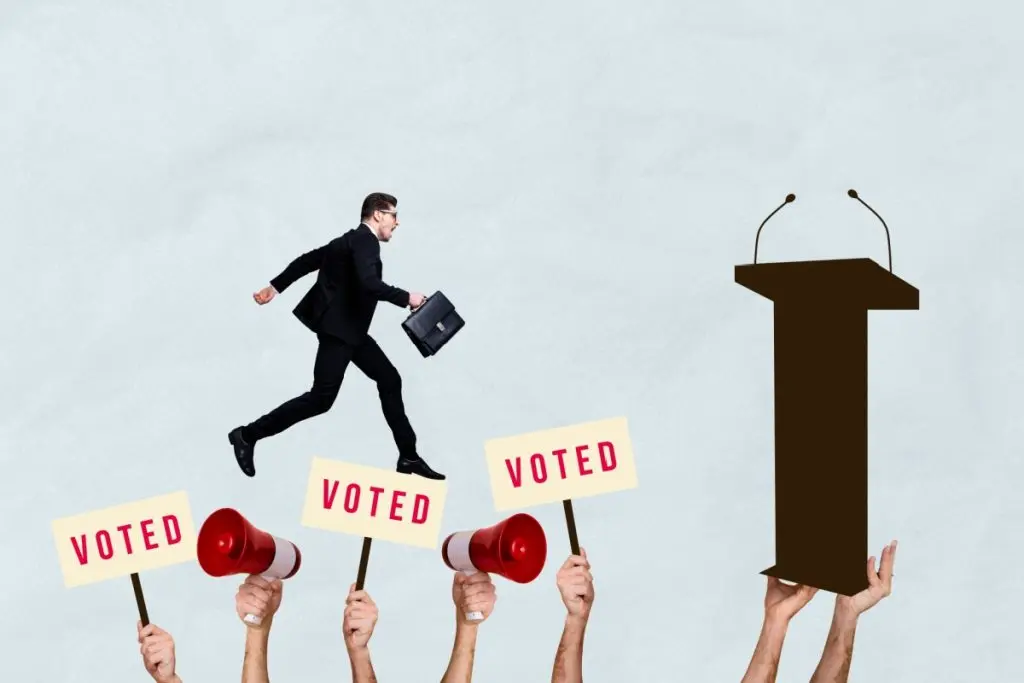Before you run for president, we recommend doing the numbers. Getting the biggest job in the country isn’t cheap, and even CEOs of big companies may struggle to fund a presidential candidacy.
If you’re wondering how much it costs to run for president, read for our detailed look.
KEY TAKEAWAYS
- Running for president is expensive. Total costs range from hundreds of millions to over a billion dollars.
- Advertising is the most significant expense, with campaigns spending over $1 billion on media in recent elections.
- Presidential funding comes from various sources, such as individual donations, Super PACs, personal wealth, and public financing.
- Campaign spending varies by state, with battleground states receiving up to $100 million.
Significant Expenses in a Presidential Campaign
Have you ever wondered how much it costs to run for president? Let’s categorize expenses and take a closer look at some average costs:
1. Advertising and Media
Advertising is one of the most significant expenses in a presidential campaign. Candidates and their teams must factor TV commercials, social media ads, and other media appearances into their budget.
In terms of costs, we can separate traditional media and digital advertising. Estimates are:
- Television and radio are considered the primary media for reaching older demographics. Depending on the market, a 30-second prime-time TV spot can cost anywhere from $100,000 to over $500,000.
- Campaigners invest heavily in online ads to target younger audiences. According to reports from the 2020 U.S. presidential election, the Biden and Trump campaigns collectively spent over $100 million on digital advertising.
And if you’re wondering how much it costs to run for president and target both old and young demographics, look at the latest U.S. election. In 2020, candidates spent over $1 billion on advertising alone.
2. Staff Salaries
Naturally, a presidential campaign requires an extensive and skillful team. Campaign managers, policy advisors, and communication directors are foundational in creating a winning strategy. However, volunteers and field organizers only sometimes qualify as top staff.
So, to break it down cost-wise, let’s separate the staff into two:
Top Staff
- Campaign managers are responsible for overall strategy and operations. Salaries for these positions can reach $200,000 or more annually.
- Senior advisors are experts in policy and communications. They earn between $120,000 to $180,000 a year.
Field Organizers
- Field organizers manage grassroots efforts, coordinate volunteers, and engage with local communities. While their salaries vary based on location, average earnings are between $35,000 and $50,000 annually.
3. Travel Expenses
Candidates travel all across the country as a part of their campaigning efforts. They attend rallies, participate in debates, and do a lot of meet and greets.
The cost of private jets, security, and accommodations can add up. So, when determining how much money it takes to run for president, note that travel expenses often total several million dollars.
In fact:
- Transportation costs can reach about $20 to $30 million per campaign. This includes private jets, which cost about $5,000 to $10,000 per flight hour. On the other hand, buses typically cost $1,500 to $2,500 per day.
- Security-related expenses are usually around $5 to $10 million per campaigning term. This covers private security personnel ($50 to $100 per hour per guard), event security measures ($10,000 to $100,000 per event), and cybersecurity investments ($500,000 to $2 million).
4. Event Hosting
Hosting rallies and fundraising events certainly isn’t cheap. Presidential teams must rent venues, invest in security, and pay for staging and other items. A closer look at the costs reveals:
- Large rallies can cost $100,000 to over $1 million per event.
- Organizing an upscale fundraising dinner ranges from $50,000 to $500,000.
5. Office Expenses
Running multiple campaign offices nationwide can add up. Over one campaign period, candidates typically spend from $2 to $7 million. They spend this on:
- Computers, phones, and office supplies
- Monthly rent payments for office spaces
- Monthly utilities
- Maintenance and upkeep
6. Voter Data and Analytics
Access to voter data allows for effective targeting. But it comes with a hefty price tag. Candidates spend around $4.5 to $10 million on:
- Access to voter databases
- Investing in analytics experts
- Purchasing strong cybersecurity and data management systems
The Cost of Running a Campaign in Different States
Understanding how much money it takes to run for president means looking at state-level expenses. These vary based on the state’s importance in the electoral college. Therefore, campaigns allocate resources strategically and focus more on states that could swing the election.

| State Type | Estimated Campaign Spending |
| Battleground States (e.g., Florida, Ohio, Pennsylvania) | $50 million–$100 million per state |
| Safe States (e.g., California, Texas) | $10 million–$30 million per state |
| Smaller States (e.g., Vermont, Wyoming) | $1 million–$5 million per state |
- Battleground states see the highest campaign spending due to their potential to swing the election. Advertising costs are high because both candidates are vying for airtime.
- Despite large populations, safe states may see less campaign activity if their outcomes are considered predictable.
- Smaller states with fewer electoral votes might receive minimal campaign attention, resulting in less spending.
How Candidates Get Funded
So, having reviewed these enormous costs, how much money do you need to run for president? And more importantly, where does all of this money come from? Well, there are several familiar sources.

- Individual donations
- Super PACs
- Personal wealth
- Public funding
Let’s take a closer look at each of these.
Donations
The bulk of campaign funding comes from individual donations. Supporters across the country contribute varying amounts, from small-dollar contributions to the maximum allowed by law, which is $3,300 per election per individual as of 2023, according to the Federal Election Commission.
- Grassroots support is small donations from many supporters that can add up significantly.
- Major donors are wealthy individuals who can contribute substantial amounts within legal limits.
Super PACs
Super Political Action Committees (Super PACs) can raise unlimited sums of money from corporations, unions, associations, and individuals. According to the Federal Election Commission, while they cannot coordinate directly with the candidates, they spend millions on independent advertising to support or oppose candidates.
Personal Savings
While rare, sometimes the wealthiest people in the world will fund their candidacy. For example, billionaire candidates like Michael Bloomberg and Ross Perot financed their campaigns mainly from their pockets.
Forbes notes that in the 2020 election, Michael Bloomberg reportedly spent over $1 billion of his own money. Using personal funds can reduce reliance on external funding but also pose a risk to one’s financial well-being.
Public Funding
Eligible candidates can receive public funds from the Federal Election Commission. If one accepts these funds, they must agree to spending limits. 2020, for instance, the spending limit was approximately $50 million. This is why many candidates choose to opt out of this program.
To qualify for public funding, a candidate must raise at least $5,000 in individual contributions of $250 or less in at least 20 states. This demonstrates a broad base of public support.
The government matches individual contributions dollar-for-dollar up to $250 per individual donor. For example, if a supporter donates $200, the campaign receives an additional $200 from public funds. If a supporter donates $500, only the first $250 is matched.
Running for president isn’t only about ambition and public support. An aspiring candidate must also consider how much it costs to run for president. Depending on the race’s competitiveness, this number can range from hundreds of millions to over a billion dollars. And while the financial barriers to entry are high, the funding sources are diverse: a mix of grassroots support and large-scale contributions.